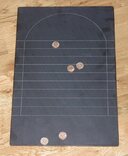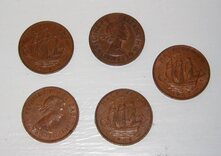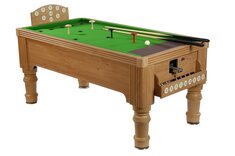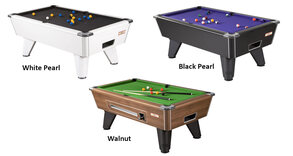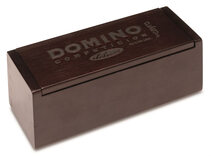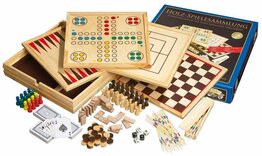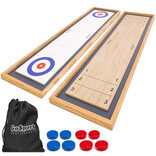The Rules of Shove Ha'penny
Being a traditional pub game without any national governing body, variations of equipment and rules abound. Where there is doubt, locally played rules should always apply. Note: 1 inch = 2.54cm
See also: Shove Ha'penny Boards.
The Equipment
The board is usually about twenty inches by fourteen inches and can can be made from slate, teak, mahogany or occasionally glass or marble. Ten indented horizontal lines lie across the board, each one having a thickness of about a thirty-secondth of an inch. The first horizontal line is four inches from the front of the board and the last horizontal line is about five inches from the rear of the board. The nine areas between the lines are called 'beds' and each bed is one and a quarter inches wide. Sometimes, a wooden barrier is stuck to the end of the board to prevent the ha'pennies from sliding off the end. An inch and a quarter in from either side, a vertical line runs the length of the board so that the end of each bed has a square area which is used for scoring. All lines on the board are indented slightly - perhaps a sixteenth of an inch. Expensive wooden boards sometimes have much deeper slots with brass rails in them that protrude from one side and are hinged on the other. To judge whether a Ha'penny is touching a line or not, the rail is briefly lifted out of the slot and if the coin moves, it was not within the bed and does not score. A variety of substances can be used to make the board sufficiently slippery but French chalk may be preferable and talcum powder is good modern alternative. The five ha'pennies should have their tails side smoothed down so that they slide easily.
The Game
Each player shoves five coins up the board in each turn. To prepare each coin to be pushed, the player positions the Ha'penny at the front of the board with the rear of the coin just sticking over the front edge of the board. Any part of the hand can then be used to shove the coin up the board. If a coin does not actually reach the first line on the board, that coin does not count as having been played and can be shoved again. At the end of the turn each coin that is completely within a 'bed' (between two horizontal lines and within the bordering vertical lines) scores a point for that player in that bed. The points are scored with chalk marks in the squares at either end of the bed on the edge of the board, one player owning the right side, the other, the left. The aim is to get three chalk marks in each of the squares - three scores in each of the nine beds. However, once three scores have been made in a bed, any further scores in that bed will be given to the opponent instead, unless the opponent already has three scores in the bed. The one exception to this is the winning point which must be scored properly by the winning player, not given away. Good players will attempt to cause a coin to knock onto one or more previously pushed ha'pennies in an effort to improve their position as well as trying to make a score with the Ha'penny being played. A little thought is also required - it is not usually a good move to score the third coin in a bed until towards the end of a game...
Variant - Progressive Shove Ha'penny
Around the Oxford area, a modification to the above rules allows for "breaks" in the same vein as for Billiards, Snooker or Croquet. In this, any scoring Ha'penny is retrieved at the end of a turn and allowed to be replayed for another time. Once these replayed coins have been played again, any scoring coins are again replayed and so on. In this way, a turn can go on for some time and it has been known for the starting player to win the game before the second player has been allowed a turn. Masters Games recommends that a coin finishing in a bed in which that player has already made 3 scores should not be replayed, although this rule may vary according to the location.
These rules are provided by Masters Traditional Games, an Internet shop selling quality traditional games, pub games and unusual games. For general information or for copying and copyright, see our Rules Information page.
Our rules are comprehensive instructions for friendly play. If in doubt, always abide by locally-played or house rules.
Copyright James Masters, 2025. All rights reserved.


